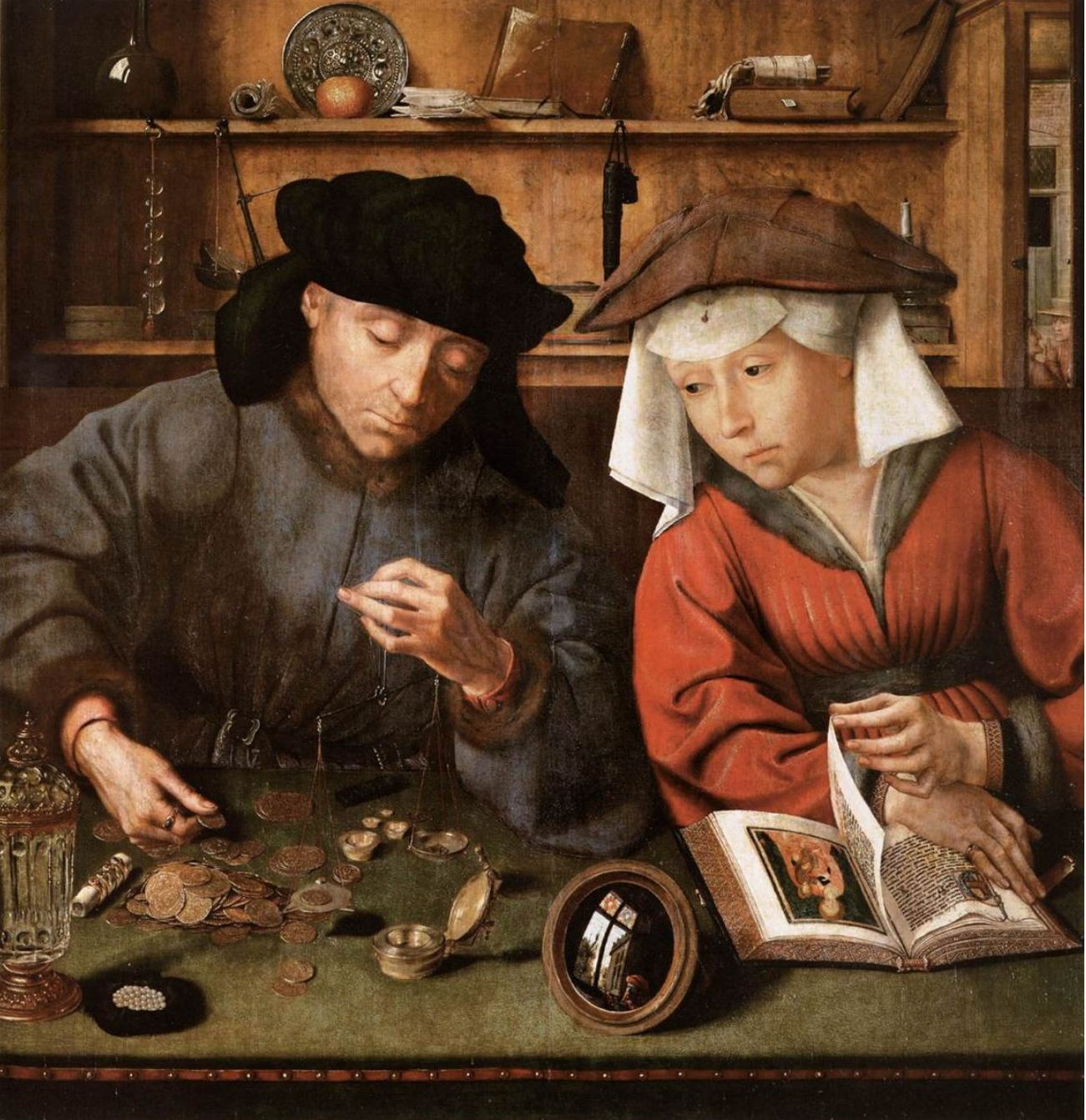The Money Changer and his Wife
In this article, Nakul PANJABI (ESSEC Business School, Grande Ecole Program – Master in Management, 2021-2024) talks about the The Money Changer and his Wife painting by Quentin Matsys and the related subject of foreign exchange markets.
About the The Money Changer and his Wife painting
This painting called ‘The Money Changer and his Wife’ was painted in 1514 by Quentin Matsys, a 16th century Flemish Artist. It originated at a time when Belgium saw an increase in the number immigrants from Spain and neighboring countries because of the Spanish Inquisition. The immigrants needed local money to buy goods and services in Belgium. Therefore, the business of money changers thrived at that time.
The Money Changer and his Wife painting

Source: Quentin Matsys (Louvre Museum).
In fact, the city of Antwerp was growing in importance at that time. Earlier, Bruges was the trading capital of Belgium. In 13th century, Bruges was the leading trade centre of the North-western Europe and the world’s ever first Stock Exchange was founded in Bruges. However, due to silting up of Zwin due to tidal inlet, Bruges lost access to the North Sea and suffered from economic decline.
At the end of the 15th Century, most foreign trading houses shifted from Bruges to Antwerp and Antwerp became the Sugar capital of Europe. The city attracted Sugar traders from all around the Europe and became a major trading hub. Moneylenders and Financiers capitalized this opportunity and Antwerp became developed an efficient Bourse (Stock Exchange) that even lent money to the English Government.
Money Changer
A money changer was a person who exchanged coins or currency of one country for that of another. Many European cities and towns produced their own coinage during the Middle Ages, and these coins frequently featured the faces of their rulers, such as the local bishop or baron.
It became necessary to exchange foreign coins for local ones at neighborhood money changers when visitors from the outside world—especially traveling merchants—came to town for a market fair.
A foreign coin would be evaluated by money changers for its type, condition, and legitimacy before being accepted as a deposit and having its value converted into local money. The money could then be withdrawn by the merchant in local currency to complete a transaction. This was the humble yet prosperous beginning of the modern day banking and foreign exchange.
As mentioned on the Louvre Museum website, through its deployment of Christian symbolism (representation of the Bible), this depiction of a money changer’s store acts as a moral lesson on the spiritual need to resist worldly temptations (the woman is not looking at the Bible but the money).
The two subjects are pictured sitting behind a table, half-length. They become the center of attention because of how tightly the scenario is framed. They are symmetrical to the letter. On the table in front of him, the man is busy weighing the pearls, gems, and gold pieces. This is keeping his wife from finishing the devotional book she is now reading, as seen by the image of the Virgin and Child.
This painting can currently be seen in the Louvre Museum in Abu Dhabi.
The History of Forex
Trading between tribes began as early as 6000 BC. People started trading by exchanging one good for another. This was followed by systems in which goods like salt and spices became common media of exchange.
Then around 6th century BC societies started using coins as a medium of exchange. The main reasons were portability, durability, divisibility, uniformity, limited supply and acceptability. Most coins were valued by the purity and type of metal used, its weight and its stamp. Gold coins became the most common form of currency around the world.
However, in the 1800’s countries started adopting Gold Standard. England, USA, and other major countries adopted a system in which a piece of paper (fiat currency) is equal to a certain value of gold that can be redeemed by the holder of this paper from the government. Since the notes were a promise to pay a certain level of gold from the government, the value of that paper became equal to the value of gold it was backed by.
During the First and Second World Wars, the limits of this system were tested when the European countries needed to print more money to pay for the war. This led to the creation of Bretton Woods System. In this system, all the major currencies would be pegged (fixed rate) to the US Dollar and the US Dollar would be pegged to gold. It made sense as USD was the benchmark currency at that time and US had the majority of gold reserves in the world. The shortage of gold relative to the US dollars in circulation brought an end to the Bretton Woods agreement in 1971.
After a series of failed agreements, countries made the switch to the free-floating system that we know today. In this system the value of one currency in other currency’s terms is decided by the relative supply and demand of the currencies. Before the Internet, the major players in this market were large financial institutions and central banks. With the internet, anybody with a computer and access to internet can access the forex market and exchange currencies. This changed everything not just for Forex market but also for other financial markets. Now investing in or trading with another country became extremely easy. The costs (spreads) were reduced, and the movement of money (capital) was faster than ever.
The History of Forex

Source: Daily FX.
Although the Forex Markets, as we know it, are relatively new, people have always been exchanging currencies for trade. This lead to a creation and prosperity of a very specific profession- Money Changing.
Related posts on the SimTrade blog
▶ Nakul PANJABI Art as a financial asset class
▶ Nakul PANJABI Charging Bull on Wall Street
▶ Louis DETALLE What are the different financial products traded in financial markets?
Useful resources
About the painting
Wikipedia The Money Changer and His Wife
Louvre Abu Dhabi The Money Changer and His Wife
Joy Of Museums virtual Tours “The Money Changer and His Wife” by Quentin Matsys
Brugge Brugge: History in a nutshell
About the foreign exchange
Daily FX The History of Forex
About the author
The article was written in November 2022 by Nakul PANJABI (ESSEC Business School, Grande Ecole Program – Master in Management, 2021-2024).

